A Paper-Based Analytical Device Integrated with Smartphone: Fluorescent and Colorimetric Dual-Mode Detection of β-Glucosidase Activity
Abstract
:1. Introduction
2. Materials and Methods
2.1. Materials and Reagents
2.2. Instrumentation
2.3. The Fabrication of Paper-Based Analytical Device
2.4. Fluorescent and Colorimetric Dual-Mode Detection of β-Glucosidase Activity by the Paper-Based Device
2.5. β-Glucosidase Assay in Real Samples
3. Results and Discussion
3.1. Sensing Mechanism
3.2. Selection of Fluorescent Signal
3.3. Optimization of the Paper-Based Analytical Device
3.4. Analytical Performance of the Developed Paper-Based Analytical Device
3.5. Specificity of the Paper-Based Analytical Device for β->Glucosidase Detection
3.6. Real Samples Analysis
4. Conclusions
Author Contributions
Funding
Institutional Review Board Statement
Informed Consent Statement
Data Availability Statement
Conflicts of Interest
References
- Liu, Z.; Liu, S.; Gao, D.; Li, Y.; Tian, Y.; Bai, E. An optical sensing platform for beta-glucosidase activity using protein-inorganic hybrid nanoflowers. J. Fluoresc. 2022, 32, 669–680. [Google Scholar] [CrossRef] [PubMed]
- Veena, V.; Poornima, P.; Parvatham, R.; Kalaiselvi, K. Isolation and characterization of β-glucosidase producing bacteria from different sources. Afr. J. Biotechnol. 2011, 10, 14907–14912. [Google Scholar] [CrossRef]
- Ketudat Cairns, J.R.; Mahong, B.; Baiya, S.; Jeon, J.S. beta-Glucosidases: Multitasking, moonlighting or simply misunderstood? Plant Sci. 2015, 241, 246–259. [Google Scholar] [CrossRef] [PubMed]
- Morant, A.V.; Jorgensen, K.; Jorgensen, C.; Paquette, S.M.; Sanchez-Perez, R.; Moller, B.L.; Bak, S. β-Glucosidases as detonators of plant chemical defense. Phytochemistry 2008, 69, 1795–1813. [Google Scholar] [CrossRef] [PubMed]
- Kitatani, K.; Sheldon, K.; Rajagopalan, V.; Anelli, V.; Jenkins, R.W.; Sun, Y.; Grabowski, G.A.; Obeid, L.M.; Hannun, Y.A. Involvement of acid beta-glucosidase 1 in the salvage pathway of ceramide formation. J. Biol. Chem. 2009, 284, 12972–12978. [Google Scholar] [CrossRef] [Green Version]
- Futerman, A.H.; Sussman, J.L.; Horowitz, M.; Silman, I.; Zimran, A. New directions in the treatment of Gaucher disease. Trends Pharmacol. Sci. 2004, 25, 147–151. [Google Scholar] [CrossRef]
- Li, Y.; Sekine, T.; Funayama, M.; Li, L.; Yoshino, H.; Nishioka, K.; Tomiyama, H.; Hattori, N. Clinicogenetic study of GBA mutations in patients with familial Parkinson’s disease. Neurobiol. Aging 2014, 35, 935.e3–935.e8. [Google Scholar] [CrossRef] [PubMed] [Green Version]
- Moreno, J.L.G.C.; Torronteras, A.R.; González, M.D.R.; Palomares, L.I.; Valverde, D.B.; Laguna, J.R.; Rubio, A.D.; López-Barea, J. The β-glucosidase assay: A new diagnostic tool for necrotizing enterocolitis. Sensitivity, specificity, and predictive values. Eur. J. Pediatr. 2016, 175, 931–941. [Google Scholar] [CrossRef]
- Kalaiyarasan, G.; Veerapandian, M.; JebaMercy, G.; Balamurugan, K.; Joseph, J. Amygdalin-Functionalized carbon quantum dots for probing β-glucosidase activity for cancer diagnosis and therapeutics. ACS Biomater. Sci. Eng. 2019, 5, 3089–3099. [Google Scholar] [CrossRef]
- De Ovalle, S.; Brena, B.; González-Pombo, P. Influence of beta glucosidases from native yeast on the aroma of Muscat and Tannat wines. Food Chem. 2021, 346, 128899. [Google Scholar] [CrossRef] [PubMed]
- Strahsburger, E.; de Lacey, A.M.L.; Marotti, I.; DiGioia, D.; Biavati, B.; Dinelli, G. In vivo assay to identify bacteria with β-glucosidase activity. Electron. J. Biotechnol. 2017, 30, 83–87. [Google Scholar] [CrossRef]
- Jin, M.Y.; Zhang, T.; Yang, Y.S.; Ding, Y.; Li, J.S.; Zhong, G.R. A simplified and miniaturized glucometer-based assay for the detection of β-glucosidase activity. J. Zhejiang Univ.-SCI. B 2019, 20, 264–272. [Google Scholar] [CrossRef]
- Zhang, L.; Fu, Q.; Li, W.; Wang, B.; Yin, X.; Liu, S.; Xu, Z.; Niu, Q. Identification and characterization of a novel beta-glucosidase via metagenomic analysis of Bursaphelenchus xylophilus and its microbial flora. Sci. Rep. 2017, 7, 14850. [Google Scholar] [CrossRef] [Green Version]
- Adetunji, A.T.; Lewu, F.B.; Mulidzi, R.; Ncube, B. The biological activities of β-glucosidase, phosphatase and urease as soil quality indicators: A review. J. Soil Sci. Plant Nutr. 2017, 17, 794–807. [Google Scholar] [CrossRef] [Green Version]
- Chróst, R.J. Characterization and significance of β-glucosidase activity in lake water. Limnol. Oceanogr. 1989, 34, 660–672. [Google Scholar] [CrossRef]
- Liu, J.; Bao, H.; Liu, C.; Wu, F.; Gao, F. “Turn-On” fluorescence determination of β-Glucosidase activity using fluorescent polymer nanoparticles formed from polyethylenimine cross-linked with hydroquinone. ACS Appl. Polym. Mater. 2019, 1, 3057–3063. [Google Scholar] [CrossRef]
- Serdiuk, I.E.; Reszka, M.; Myszka, H.; Krzymiński, K.; Liberek, B.; Roshal, A.D. Flavonol-based fluorescent indicator for determination of β-glucosidase activity. RSC Adv. 2016, 6, 42532–42536. [Google Scholar] [CrossRef] [Green Version]
- Li, Y.; Wang, H.; Li, J.; Zheng, J.; Xu, X.; Yang, R. Simultaneous intracellular β-D-glucosidase and phosphodiesterase I activities measurements based on a triple-signaling fluorescent probe. Anal. Chem. 2011, 83, 1268–1274. [Google Scholar] [CrossRef]
- Liu, Z.; Tian, Y.; Han, Y.; Bai, E.; Li, Y.; Xu, Z.; Liu, S. A “turn off-on” fluorescent nanoprobe consisting of CuInS2 quantum dots for determination of the activity of β-glucosidase and for inhibitor screening. Mikrochim. Acta 2019, 186, 806. [Google Scholar] [CrossRef]
- Chen, G.Y.; Zhang, H.; Yang, F.Q. A simple and portable method for β-Glucosidase activity assay and its inhibitor screening based on a personal glucose meter. Anal. Chim. Acta. 2021, 1142, 19–27. [Google Scholar] [CrossRef] [PubMed]
- Chen, C.; Zhao, D.; Wang, B.; Ni, P.; Jiang, Y.; Zhang, C.; Yang, F.; Lu, Y.; Sun, J. Alkaline phosphatase-triggered in situ formation of silicon-containing nanoparticles for a fluorometric and colorimetric dual-channel immunoassay. Anal. Chem. 2020, 92, 4639–4646. [Google Scholar] [CrossRef] [PubMed]
- Shen, Y.; Gao, X.; Zhang, Y.; Chen, H.; Ye, Y.; Wu, Y. Polydopamine-based nanozyme with dual-recognition strategy-driven fluorescence-colorimetric dual-mode platform for Listeria monocytogenes detection. J. Hazard. Mater. 2022, 439, 129582. [Google Scholar] [CrossRef]
- Luo, X.; Huang, G.; Li, Y.; Guo, J.; Chen, X.; Tan, Y.; Tang, W.; Li, Z. Dual-modes of ratiometric fluorescent and smartphone-integrated colorimetric detection of glyphosate by carbon dots encapsulated porphyrin metal–organic frameworks. Appl. Surf. Sci. 2022, 602, 154368. [Google Scholar] [CrossRef]
- Yu, K.; Li, M.; Chai, H.; Liu, Q.; Hai, X.; Tian, M.; Qu, L.; Xu, T.; Zhang, G.; Zhang, X. MOF-818 nanozyme-based colorimetric and electrochemical dual-mode smartphone sensing platform for in situ detection of H2O2 and H2S released from living cells. Chem. Eng. J. 2023, 451, 138321. [Google Scholar] [CrossRef]
- Müller, R.H.; Clegg, D.L. Automatic paper chromatography. Anal. Chem. 1949, 21, 1123–1125. [Google Scholar] [CrossRef]
- Martinez, A.W.; Phillips, S.T.; Butte, M.J.; Whitesides, G.M. Patterned paper as a platform for inexpensive, low-volume, portable bioassays. Angew. Chem. Int. Edit. 2007, 46, 1318–1320. [Google Scholar] [CrossRef] [Green Version]
- Yang, Y.; Noviana, E.; Nguyen, M.P.; Geiss, B.J.; Dandy, D.S.; Henry, C.S. Paper-based microfluidic devices: Emerging themes and applications. Anal. Chem. 2017, 89, 71–91. [Google Scholar] [CrossRef]
- Sun, L.; Jiang, Y.; Pan, R.; Li, M.; Wang, R.; Chen, S.; Fu, S.; Man, C. A novel, simple and low-cost paper-based analytical device for colorimetric detection of Cronobacter spp. Anal. Chim. Acta 2018, 1036, 80–88. [Google Scholar] [CrossRef] [PubMed]
- Soum, V.; Park, S.; Brilian, A.I.; Kwon, O.S.; Shin, K. Programmable paper-based microfluidic devices for biomarker detections. Micromachines 2019, 10, 516. [Google Scholar] [CrossRef] [Green Version]
- Martinez, A.W.; Phillips, S.T.; Whitesides, G.M.; Carrilho, E. Diagnostics for the developing world: Microfluidic paper-based analytical devices. Anal. Chem. 2010, 82, 3–10. [Google Scholar] [CrossRef]
- Zhang, H.; Li, X.; Qian, Z.M.; Wang, S.; Yang, F.Q. Glucose oxidase-mediated sodium alginate gelation: Equipment-Free detection of glucose in fruit samples. Enzyme Microb. Technol. 2021, 148, 109805. [Google Scholar] [CrossRef]
- Zhang, H.; Yang, F.Q. Equipment-free quantitative determination of urea based on paper-based sensor via urease-mediated chitosan viscosity change. Enzyme Microb. Technol. 2021, 148, 109830. [Google Scholar] [CrossRef]
- Zhang, W.-Y.; Zhang, H.; Yang, F.-Q. An economical and portable paper-based colorimetric sensor for the determination of hydrogen peroxide-related biomarkers. Chemosensors 2022, 10, 335. [Google Scholar] [CrossRef]
- Nadar, S.S.; Patil, P.D.; Tiwari, M.S.; Ahirrao, D.J. Enzyme embedded microfluidic paper-based analytic device (μPAD): A comprehensive review. Crit. Rev. Biotechnol. 2021, 41, 1046–1080. [Google Scholar] [CrossRef] [PubMed]
- Grudpan, K.; Kolev, S.D.; Lapanantnopakhun, S.; McKelvie, I.D.; Wongwilai, W. Applications of everyday IT and communications devices in modern analytical chemistry: A review. Talanta 2015, 136, 84–94. [Google Scholar] [CrossRef] [PubMed]
- Han, C.; Yuan, X.; Shen, Z.; Xiao, Y.; Wang, X.; Khan, M.; Liu, S.; Li, W.; Hu, Q.; Wu, W. A paper-based lateral flow sensor for the detection of thrombin and its inhibitors. Anal. Chim. Acta 2022, 1205, 339756. [Google Scholar] [CrossRef]
- Zhang, W.-Y.; Zhang, C.-Y.; Zhou, H.-Y.; Tian, T.; Chen, H.; Zhang, H.; Yang, F.-Q. Paper-based sensor depending on the Prussian blue pH sensitivity: Smartphone-assisted detection of urea. Microchem J. 2022, 181, 107783. [Google Scholar] [CrossRef]
- Placer, L.; Lavilla, I.; Pena-Pereira, F.; Bendicho, C. Bromine speciation by a paper-based sensor integrated with a citric acid/cysteamine fluorescent probe and smartphone detection. Sens. Actuator B Chem. 2022, 358, 131499. [Google Scholar] [CrossRef]
- Hussain, S.; Chen, X.; Wang, C.; Hao, Y.; Tian, X.; He, Y.; Li, J.; Shahid, M.; Iyer, P.K.; Gao, R. Aggregation and binding-directed FRET modulation of conjugated polymer materials for selective and point-of-care monitoring of serum albumins. Anal. Chem. 2022, 94, 10685–10694. [Google Scholar] [CrossRef] [PubMed]
- Song, J.; Pandian, V.; Mauk, M.G.; Bau, H.H.; Cherry, S.; Tisi, L.C.; Liu, C. Smartphone-Based mobile detection platform for molecular diagnostics and spatiotemporal disease mapping. Anal. Chem. 2018, 90, 4823–4831. [Google Scholar] [CrossRef] [PubMed]
- Mahato, K.; Chandra, P. Paper-based miniaturized immunosensor for naked eye ALP detection based on digital image colorimetry integrated with smartphone. Biosens. Bioelectron. 2019, 128, 9–16. [Google Scholar] [CrossRef] [PubMed]
- Lai, C.; Zeng, G.M.; Huang, D.L.; Zhao, M.H.; Wei, Z.; Huang, C.; Xu, P.; Li, N.J.; Zhang, C.; Chen, M.; et al. Synthesis of gold-cellobiose nanocomposites for colorimetric measurement of cellobiase activity. Spectroc. Acta Pt. A-Molec. Biomolec. Spectr. 2014, 132, 369–374. [Google Scholar] [CrossRef] [PubMed]
- Kong, B.; Yang, T.; Hou, P.; Li, C.H.; Zou, H.Y.; Huang, C.Z. Enzyme-triggered fluorescence turn-off/turn-on of carbon dots for monitoring β-glucosidase and its inhibitor in living cells. Luminescence 2020, 35, 222–230. [Google Scholar] [CrossRef] [PubMed]
- Gorai, T.; Maitra, U. Supramolecular approach to enzyme sensing on paper discs using lanthanide photoluminescence. ACS Sens. 2016, 1, 934–940. [Google Scholar] [CrossRef]
- Li, A.; Li, H.; Ma, Y.; Wang, T.; Liu, X.; Wang, C.; Liu, F.; Sun, P.; Yan, X.; Lu, G. Bioinspired laccase-mimicking catalyst for on-site monitoring of thiram in paper-based colorimetric platform. Biosens. Bioelectron. 2022, 207, 114199. [Google Scholar] [CrossRef] [PubMed]
- Zhan, X.; Tang, Y.; Liu, Y.; Tao, H.; Wu, Y. A novel colorimetric strategy for rapid detection of dimethoate residue in vegetables based on enhancing oxidase-mimicking catalytic activity of cube-shape Ag2O particles. Sens. Actuator B-Chem. 2022, 361, 131720. [Google Scholar] [CrossRef]
- Dong, C.; Ma, X.; Qiu, N.; Zhang, Y.; Wu, A. An ultra-sensitive colorimetric sensor based on smartphone for pyrophosphate determination. Sens. Actuator B-Chem. 2021, 329, 129066. [Google Scholar] [CrossRef]

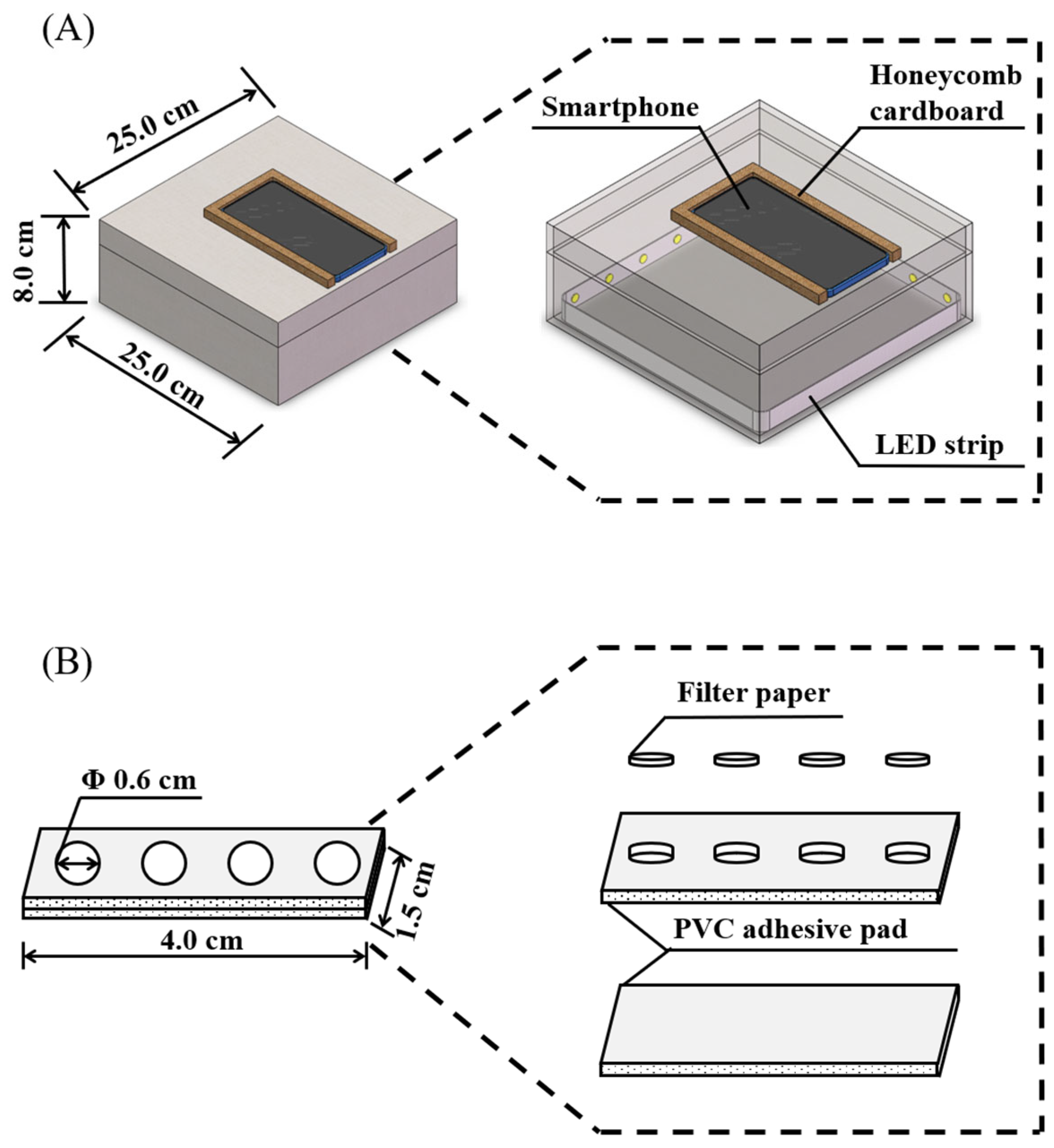
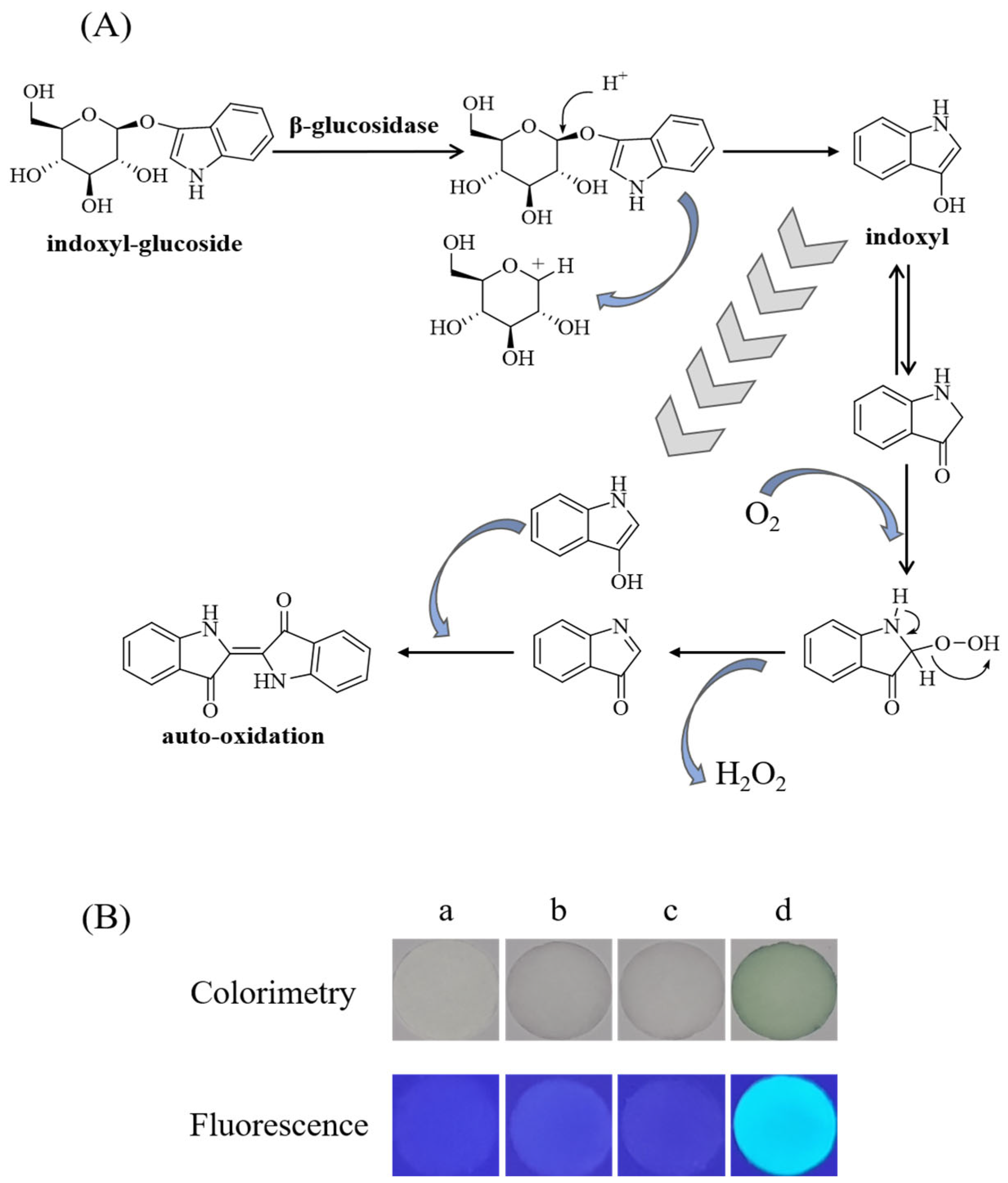
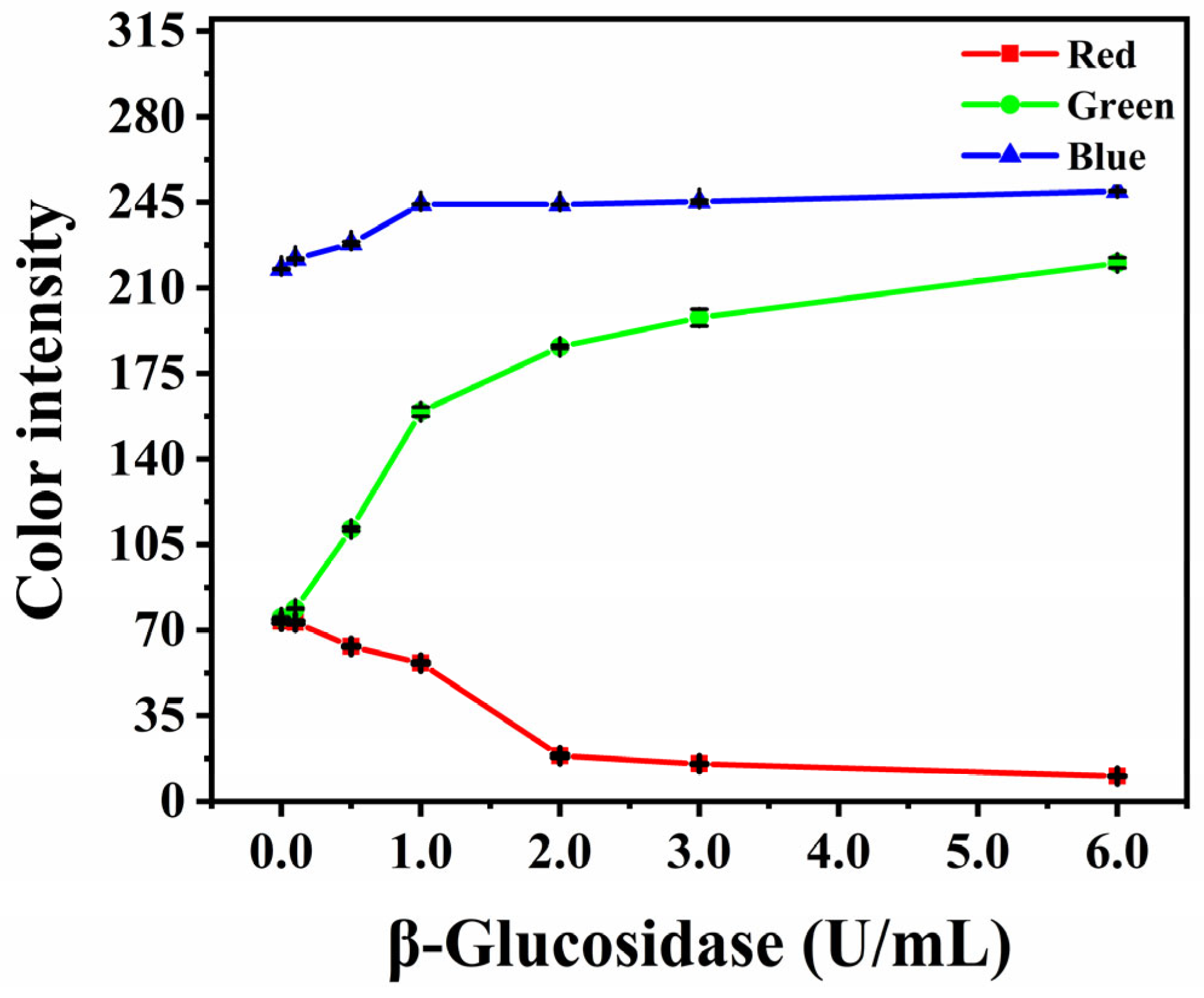
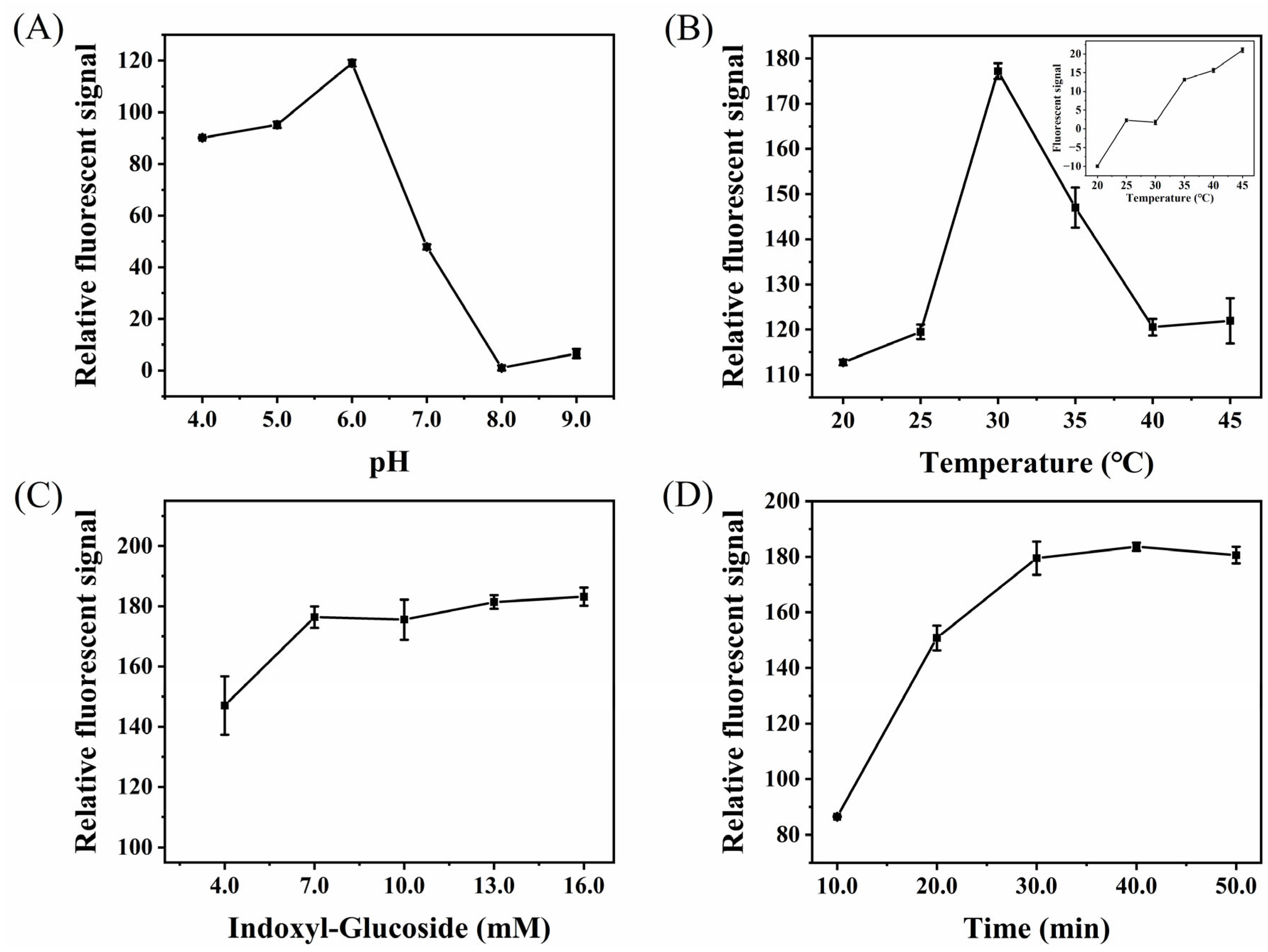
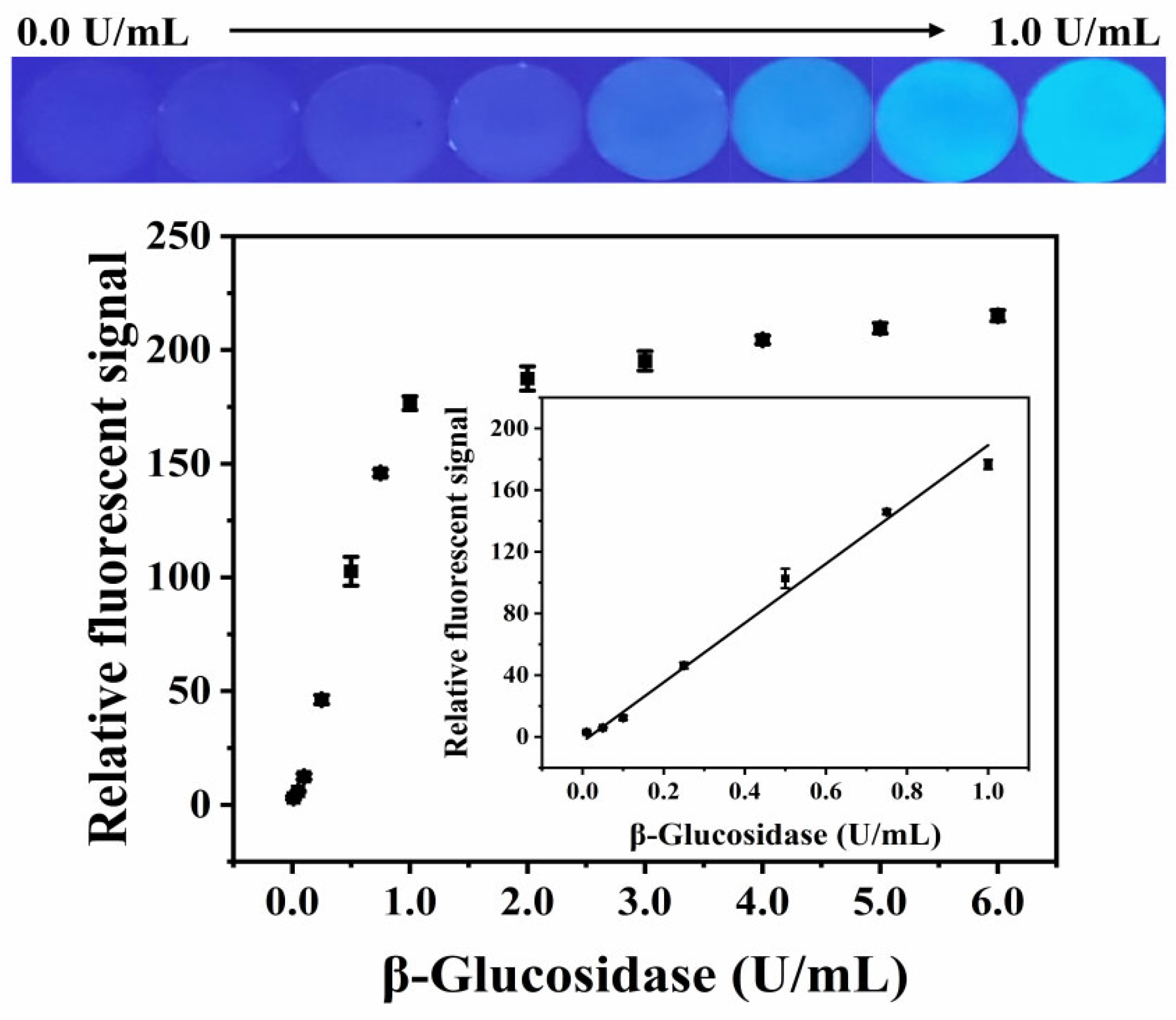
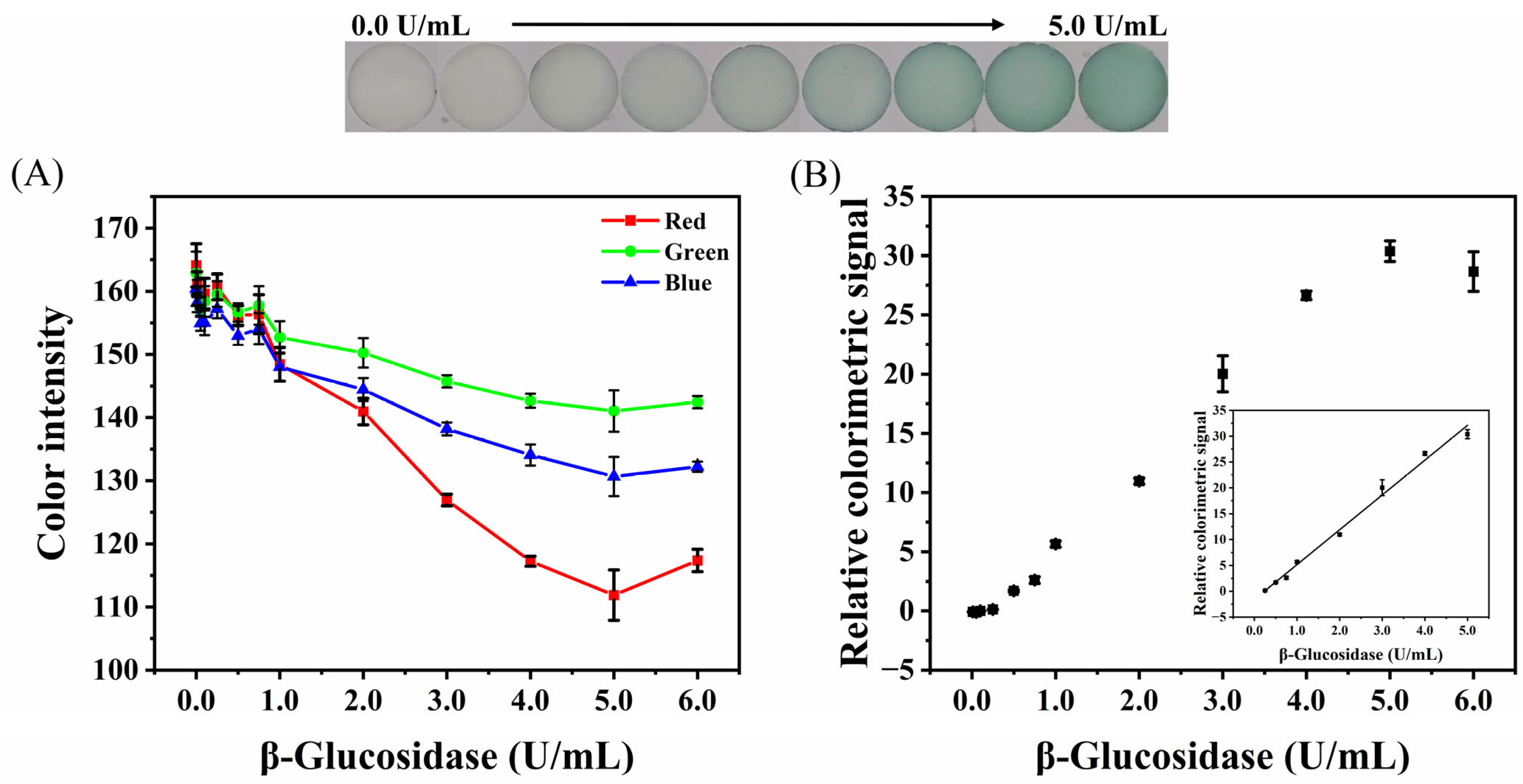
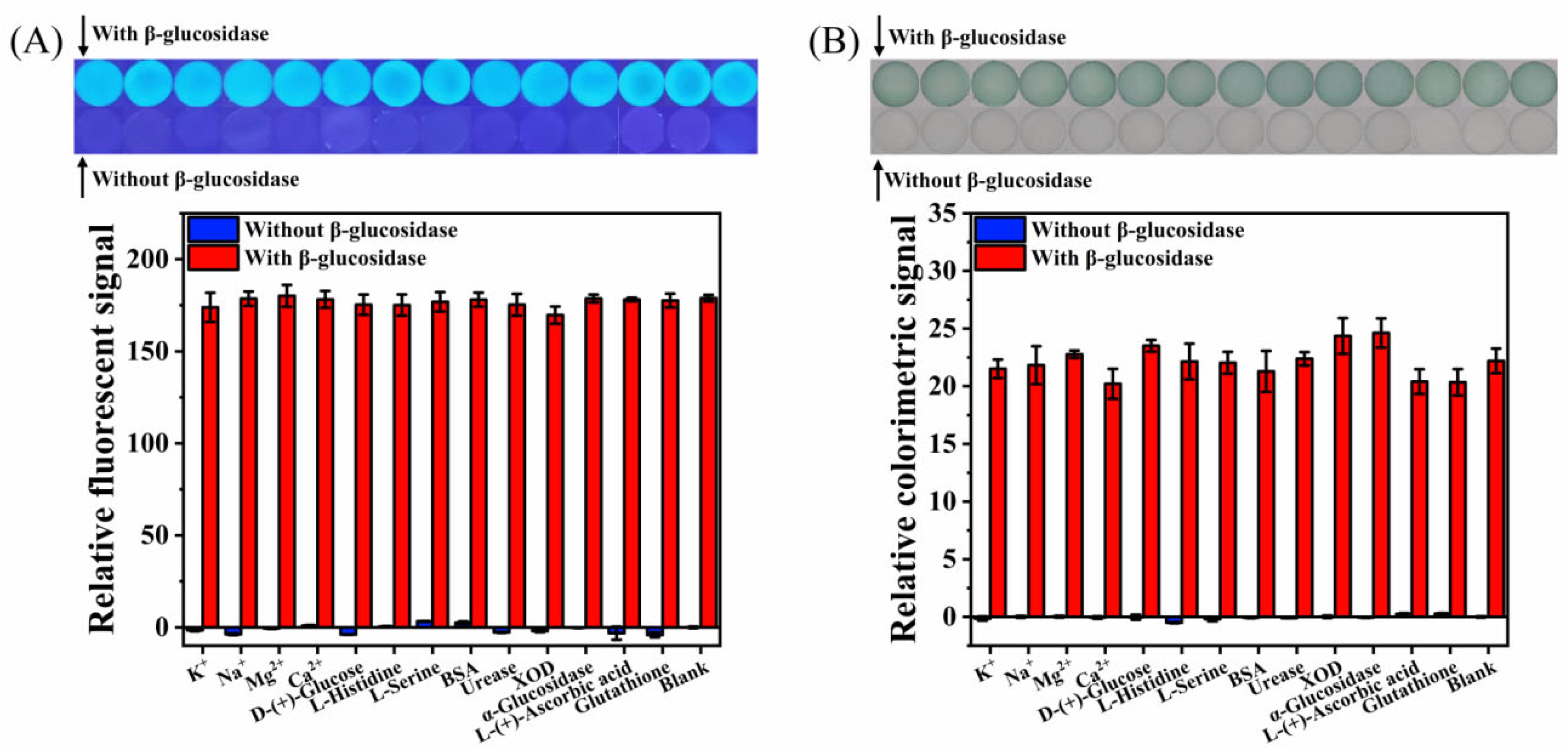
| Detection Methods | Platform | Main Materials | Linear Range (U/mL) | LOD (U/L) | Ref. |
|---|---|---|---|---|---|
| Colorimetric analysis by UV–Vis spectrophotometer | Solution | Gold–cellobiose nanocomposites | 0.003–0.100 | 1.0 | [42] |
| Glucometer-based assay | Solution | D-(−)-Salicin | 1.0–9.0 | 450 | [20] |
| Glucometer-based assay | Solution | D-(−)-Salicin | 0.0873–1.5498 | - | [12] |
| Fluorescent analysis by spectrophotometer | Solution | Carbon dot, p-nitrophenol | 0.005–0.250 | 12.3 | [43] |
| Fluorescent analysis by spectrophotometer | Solution | β-arbutin, polyethylenimine molecules | 0.001–0.036 | 0.4 | [16] |
| Fluorescent analysis by spectrophotometer | Solution | CuInS2 quantum dots, Cu2+, amygdalin | 0.0005–0.7000 | 0.2 | [19] |
| Fluorescent analysis by spectrophotometer | Solution | BSA-Cu3(PO4)2·3H2O nanoflowers, Amplex Red, hydrogen peroxide, Amygdalin | 0.0005–1.5000 | 0.33 | [1] |
| Fluorescent analysis by commercial plate reader | Paper | Mono-β-glucoside derivative of 2,3-dihydoxynaphthalene, Tb-Cholate gel | - | 76.2 | [44] |
| Fluorescent analysis by smartphone | Paper | Indoxyl-Glucoside | 0.01–1.00 | 5.0 | This work |
| Colorimetric analysis by smartphone | 0.25–5.00 | 66.8 |
| Methods | Added (U/mL) | Total Found (U/mL) | Recovery (%) | RSD (%) |
|---|---|---|---|---|
| Fluorescence | 0.00 | - a | - | - |
| 0.25 | 0.25 ± 0.02 | 101.3 | 7.3 | |
| 0.50 | 0.59 ± 0.01 | 117.9 | 2.0 | |
| 0.75 | 0.79 ± 0.01 | 105.9 | 1.1 | |
| Colorimetry | 0.00 | - a | - | - |
| 1.00 | 1.12 ± 0.02 | 112.3 | 2.2 | |
| 2.00 | 2.36 ± 0.01 | 118.0 | 0.6 | |
| 3.00 | 2.87 ± 0.10 | 95.7 | 3.6 |
| Methods | Added (U/mL) | Total Found (U/mL) | Recovery (%) | RSD (%) |
|---|---|---|---|---|
| Fluorescence | 0.0 | 0.18 ± 0.00 | - | 2.2 |
| 0.3 | 0.49 ± 0.02 | 101.0 | 4.8 | |
| 0.5 | 0.86 ± 0.02 | 96.1 | 2.4 | |
| 0.7 | 0.92 ± 0.02 | 105.4 | 1.6 | |
| Colorimetry | 0.0 | 0.37 ± 0.01 | - | 3.1 |
| 1.0 | 1.29 ± 0.07 | 92.2 | 5.7 | |
| 2.0 | 2.12 ± 0.10 | 87.7 | 4.8 | |
| 3.0 | 2.99 ± 0.16 | 87.5 | 5.2 |
Publisher’s Note: MDPI stays neutral with regard to jurisdictional claims in published maps and institutional affiliations. |
© 2022 by the authors. Licensee MDPI, Basel, Switzerland. This article is an open access article distributed under the terms and conditions of the Creative Commons Attribution (CC BY) license (https://creativecommons.org/licenses/by/4.0/).
Share and Cite
Zhang, W.-Y.; Tian, T.; Peng, L.-J.; Zhou, H.-Y.; Zhang, H.; Chen, H.; Yang, F.-Q. A Paper-Based Analytical Device Integrated with Smartphone: Fluorescent and Colorimetric Dual-Mode Detection of β-Glucosidase Activity. Biosensors 2022, 12, 893. https://doi.org/10.3390/bios12100893
Zhang W-Y, Tian T, Peng L-J, Zhou H-Y, Zhang H, Chen H, Yang F-Q. A Paper-Based Analytical Device Integrated with Smartphone: Fluorescent and Colorimetric Dual-Mode Detection of β-Glucosidase Activity. Biosensors. 2022; 12(10):893. https://doi.org/10.3390/bios12100893
Chicago/Turabian StyleZhang, Wei-Yi, Tao Tian, Li-Jing Peng, Hang-Yu Zhou, Hao Zhang, Hua Chen, and Feng-Qing Yang. 2022. "A Paper-Based Analytical Device Integrated with Smartphone: Fluorescent and Colorimetric Dual-Mode Detection of β-Glucosidase Activity" Biosensors 12, no. 10: 893. https://doi.org/10.3390/bios12100893
APA StyleZhang, W.-Y., Tian, T., Peng, L.-J., Zhou, H.-Y., Zhang, H., Chen, H., & Yang, F.-Q. (2022). A Paper-Based Analytical Device Integrated with Smartphone: Fluorescent and Colorimetric Dual-Mode Detection of β-Glucosidase Activity. Biosensors, 12(10), 893. https://doi.org/10.3390/bios12100893






